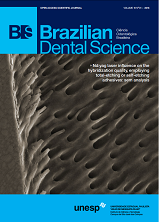Retention of class V restorations placed by dental students: a retrospective evaluation
DOI:
https://doi.org/10.14295/bds.2016.v19i1.1216Resumo
Objective: The aim of this study was to evaluate the clinical performance of class V restorations made by undergraduate students and determine the factors that might influence retention of restorations. Material and Methods: A survey of the clinical records created between 2007 and 2009 was used to collect data on patients with dental restorations. The USPHS (United States Public Health Service) criteria were used to perform evaluations by direct clinical observation. Statistical analyses were performed using Fisher’s exact test, Chi-square test, and Logistic regression analysis. Results: Clinical records were analyzed, of which 282 (21.3%) described class V restorations performed on a total of 781 teeth. These patients were contacted, and 67 (23.76%) attended the clinic for assessment. Out of the 221 (28.3%) evaluated teeth, 37 restorations were replaced and 184 were analyzed. The logistic regression analysis showed that gingival bleeding index (GBI), decay-missing-filled teeth (DMFT) index, and pulpal protection influenced the retention of the restorations. The association tests demonstrated superiority of the composite resin over the glass ionomer cement with regard to retention, wear, and anatomical form. Conclusion: In this study, retention of cervical composite resin restorations was higher than that of the glass ionomer cement restorations when performed by undergraduate students.
Key Words: Composite resins; Glass ionomer cements; Retrospective study.
Downloads
Downloads
Publicado
Como Citar
Edição
Seção
Licença
TRANSFERÊNCIA DE DIREITOS AUTORAIS E DECLARAÇÃO DE RESPONSABILIDADE
Toda a propriedade de direitos autorais do artigo "____________________________________________________________________" é transferido do autor(es) para a CIÊNCIA ODONTOLÓGICA BRASILEIRA, no caso do trabalho ser publicado. O artigo não foi publicado em outro lugar e não foi submetido simultaneamente para publicação em outra revista.
Vimos por meio deste, atestar que trabalho é original e não apresenta dados manipulados, fraude ou plágio. Fizemos contribuição científica significativa para o estudo e estamos cientes dos dados apresentados e de acordo com a versão final do artigo. Assumimos total responsabilidade pelos aspectos éticos do estudo.
Este texto deve ser impresso e assinado por todos os autores. A versão digitalizada deverá ser apresentada como arquivo suplementar durante o processo de submissão.




























